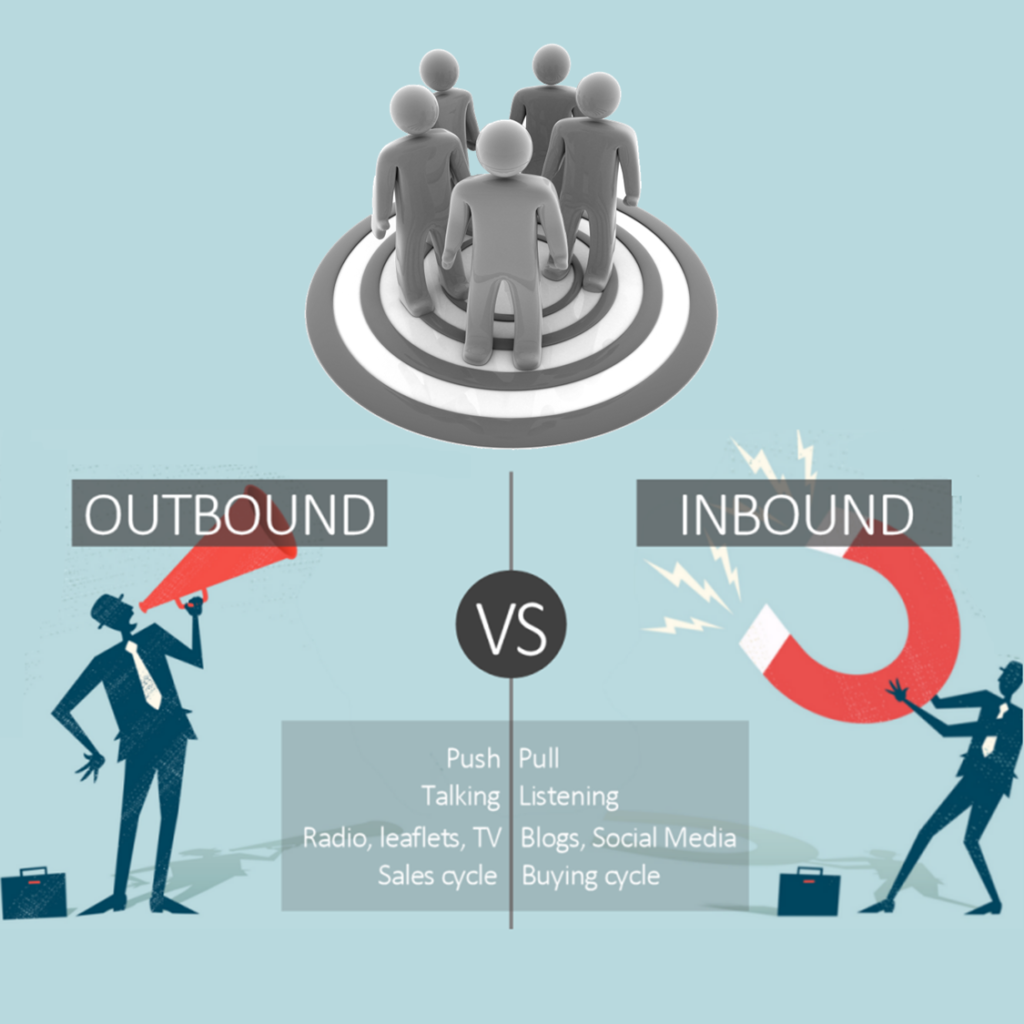For most lay people, marketing is marketing. Professionals, however, distinguish between outbound marketing and inbound marketing. Outbound marketing is considered more traditional. Marketing-Schools.org defines outbound marketing this way:
“Outbound marketing tries to reach consumers through general media advertising as well as through in-person contact. Depending on the venue, the approach can be extremely broad (TV advertising), thoroughly personal (face-to-face meetings), or ‘impersonally personal’ (cold-calling or blanket emails). Through each outbound method, sales leads are generated and then followed by internal sales representatives.”
Anyone who follows the marketing scene knows that outbound marketing has fallen on hard times. Ads in newspapers have plummeted, mobile ad spending now exceeds television ad spending, and, according to Scott Vaughan (@ScottAVaughan), Chief Marketing Officer of Integrate, “Inbound marketing is the cool kid on the block.”[1] According to Victoria Godfrey, chief marketing officer of Avention, the term inbound marketing was first coined by HubSpot back in 2005.[2] And Neil Patel (@neilpatel), co-founder of Crazy Egg, Hello Bar, and KISSmetrics, believes the term describes “more of an approach than it [does] a list of tactics.”[3] He explains:
“Inbound marketing, at its core, is about attracting prospects to your business rather than going out to find those prospects. Traditional marketing relied on email lists, cold-calling, billboard advertisements, and direct mail. Modern inbound marketing uses organic search traffic, opt-in email forms, and content publication to attract customers. Inbound marketing is the best approach for today’s businesses, whether B2B, B2C, e-commerce, SaaS, tech, non-tech, brick-and-mortar or otherwise.”
In spite of the rise of inbound marketing (which is often discussed as targeted marketing), both outbound and inbound marketing have a role to play in today’s business environment. Godfrey observes, “Some looked at inbound marketing and figured the new methodology meant abandoning outbound marketing tactics without analyzing how they could improve upon long-proven strategies with new capabilities.” Her point is well made. The same technologies that inspired inbound marketing can be put to good use in outbound marketing. Take, for example, trade promotion optimization. Trade promotions, a traditional outbound marketing method, have a long and successful history of boosting brand sales. Analysts at L.E.K. note, “Trade promotion programs are pivotal to driving sales, building brand equity with consumers and strengthening channel partnerships.”[4] There are obviously a lot of companies, including mine (Enterra Solutions®), touting their TPO solutions and most of them agree that using predictive analytics plays an important role in trade promotion. Analysts at the Synectics Group write, “Predictive analytics is the ability to utilize historical data to identify the things that influence sales, and apply that learning to forecast future sales.”[5] The best outbound marketing takes advantage of the same kind of granularity and segmentation that targeted marketing uses. Godfrey explains:
“Outbound marketing efforts succeed when they reach the right audiences. Leveraging data collected from years of successes and failures helps paint a picture of the most effective methods for filling the sales funnel with qualified, eager prospects. Whether it’s email marketing, direct mail, sales calls or any other form of outbound marketing, knowing when people are most likely to convert can make an average campaign a successful one. Moreover, sales teams empowered by analytics can glean critical insight into actual conversion triggers. Those triggers include events such as a prospect being promoted into a position with responsibility for purchasing decisions or a target company emerging on the cusp of a new trend in its industry. Big data analysis can surface those triggers so that brands can make effective decisions about outbound marketing strategy. Beyond just providing trigger information about prospects, sales and marketing teams can use big data to identify which prospects to target.”
Cognitive computing systems can help make the most of available data because such systems can deal with many more of the variables that can affect sales. Inbound marketing relies heavily on data gathered about individual consumers. To ensure that companies are attracting ideal customers, they develop personas for those customers. Kevin Page (@1nonlyKevinPage) explains, “A buyer persona is a semi-fictional representation of your ideal customer based on market research and real data about your existing customers. A detailed buyer persona will help you determine where to focus your time, guide product development, and allow for alignment across the organization. As a result, you will be able to attract the most valuable visitors, leads, and customers to your business.”[6] Similarly, outbound marketing can use available data to improve results. Vaughn explains:
“The key is to make outbound more like inbound. ‘New school’ outbound marketing leverages the same persona-based, educational content concepts employed in inbound, delivered via outbound channels, especially through the use of media partners that have highly engaged niche audiences. Like inbound, there are important methodical steps that go into successful outbound demand marketing. Because outbound typically entails using third-party media sources for fulfillment, marketers must take into account these steps, which are traditionally manual and resource-heavy:
- Identifying, onboarding and managing numerous media partners
- Gathering, scrubbing and normalizing third-party prospect data
- Uploading all this refined data into marketing automation systems
- Analyzing campaign, prospect and media source performance data and optimizing programs in flight
This is why scaling outbound programs is best executed by automating as many of these steps as possible, which entails integrating outbound systems and processes with the core tools used today for inbound (e.g., marketing automation, CRM, website analytics and content management systems).”
Cognitive computing systems excel at integrating data, analyzing it, and providing actionable insights that can improve any outbound marketing campaign. Godfrey concludes:
“Smart sales and marketing teams know that outbound is alive and well, even as they might be experimenting with complementary inbound strategies. The difference between the outbound campaigns of yesterday and those of the future comes down to data. Solutions designed to gather, organize and analyze information have become truly business-critical, and they are transforming outbound marketing campaigns that once seemed largely hit-or-miss into highly targeted strategies with multiple facets capable of reaching every kind of prospect. Real-world context, real-time triggers and highly specific buyer profiles fuel smarter, more effective outbound activity. The rise of inbound is important, but outbound marketing hasn’t been replaced, as so many want to believe. It has prompted decision-makers to get more creative and resourceful about tapping into available data.”
Marketing professionals know that they are entering a new data-driven era and companies that use the latest techniques to improve both inbound and outbound marketing will be proven winners. In both cases, using targeted marketing techniques makes a whole lot of sense.
Footnotes
[1] Scott Vaughan, “The Resurgence Of Outbound Marketing,” Marketing Land, 27 July 2015.
[2] Victoria Godfrey, “Big Data Makes For Better Outbound Marketing,” Marketing Land, 21 September 2015.
[3] Neil Patel, “6 Inbound Marketing Techniques Every Business Should Use,” Marketing Land, 28 January 2015.
[4] L.E.K., “Four Steps to Optimizing Trade Promotion Effectiveness,” Executive Insights, Volume XIII, Issue 5.
[5] “What is Trade Promotion Optimization (TPO)?” AFS Technologies & Synectics Group.
[6] Kevin Page, “Why Buyer Personas Are Crucial To Inbound Marketing Success,” Business2Community (B2C), 11 September 2015.





